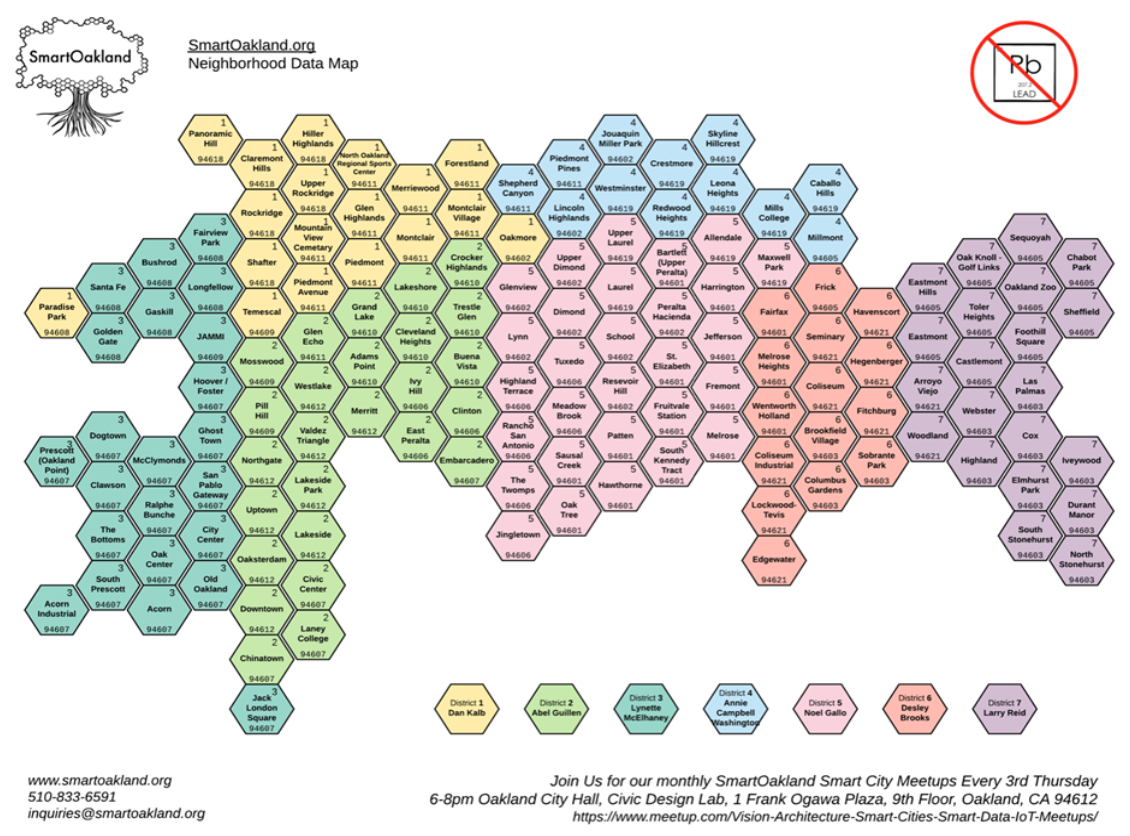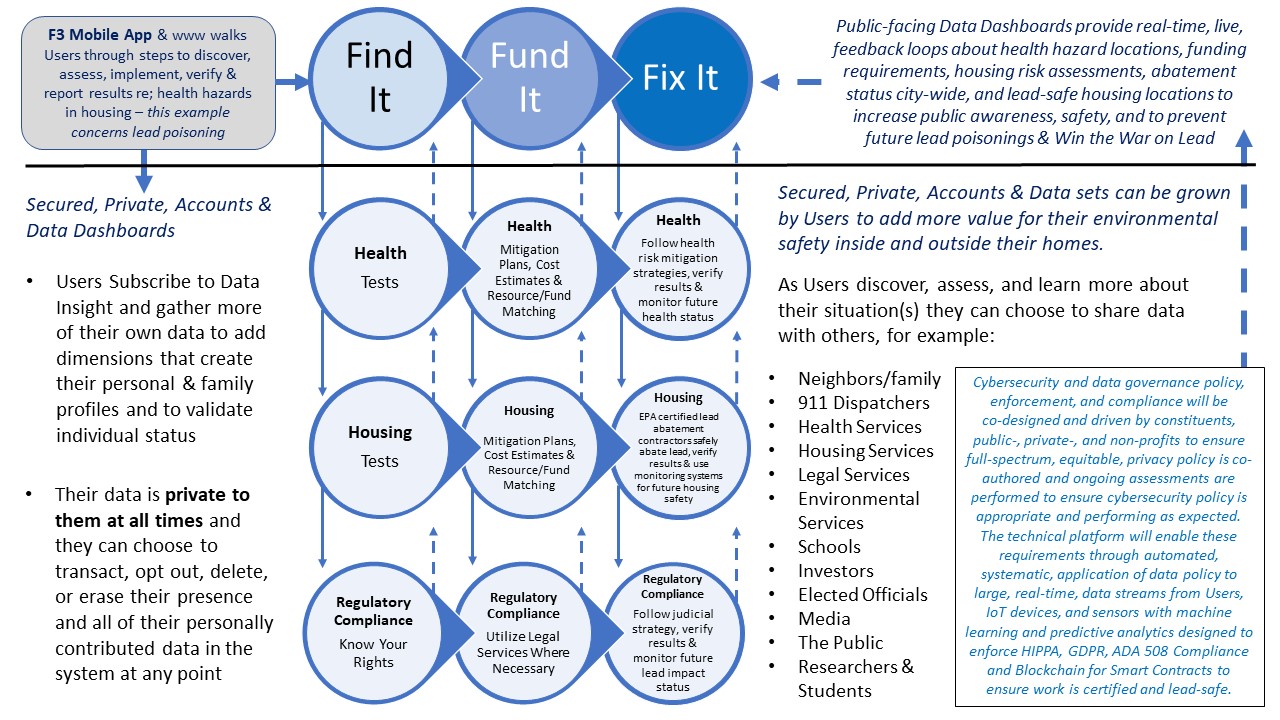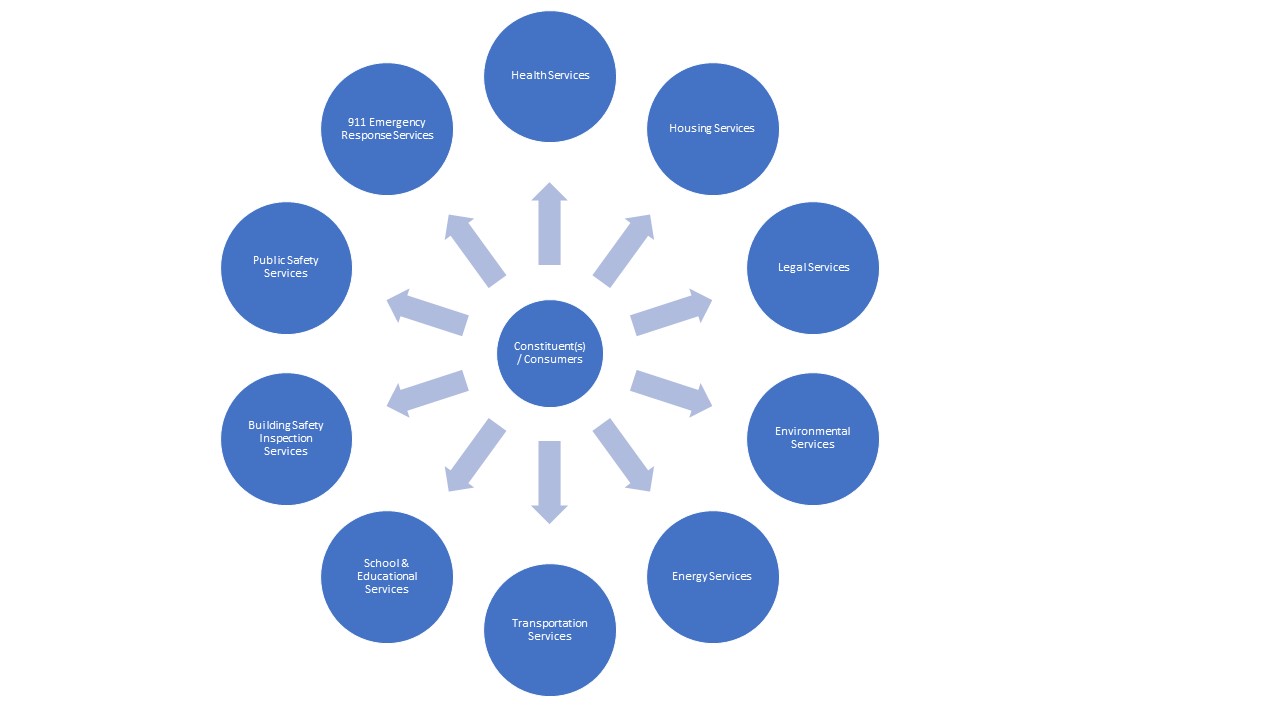Constituent-led Public Data and IoT Utility for Urban Health Housing and Environmental Hazard Management
| Constituent-led Public Data and IoT Utility for Urban Health Housing and Environmental Hazard Management | |
|---|---|
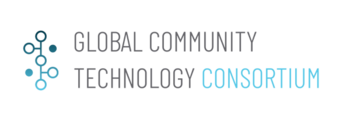
| |
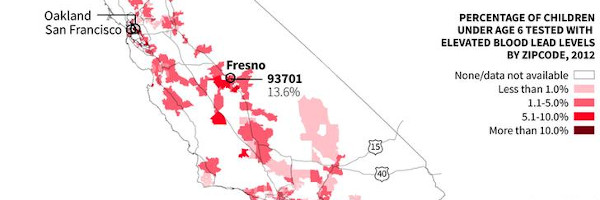 Lead Exposure in the Golden State | |
| Team Organizations | Vision Architecture Metropolitan Intelligence SmartOakland Alameda County Healthy Homes Lead Poisoning Prevention Program Revalue.io West Oakland Environmental Indicators Project Rebuilding Together Oakland East Bay |
| Team Leaders | Stephanie Hayden |
| Participating Municipalities | Oakland CA San Francisco CA |
| Status | Development |
| Document | 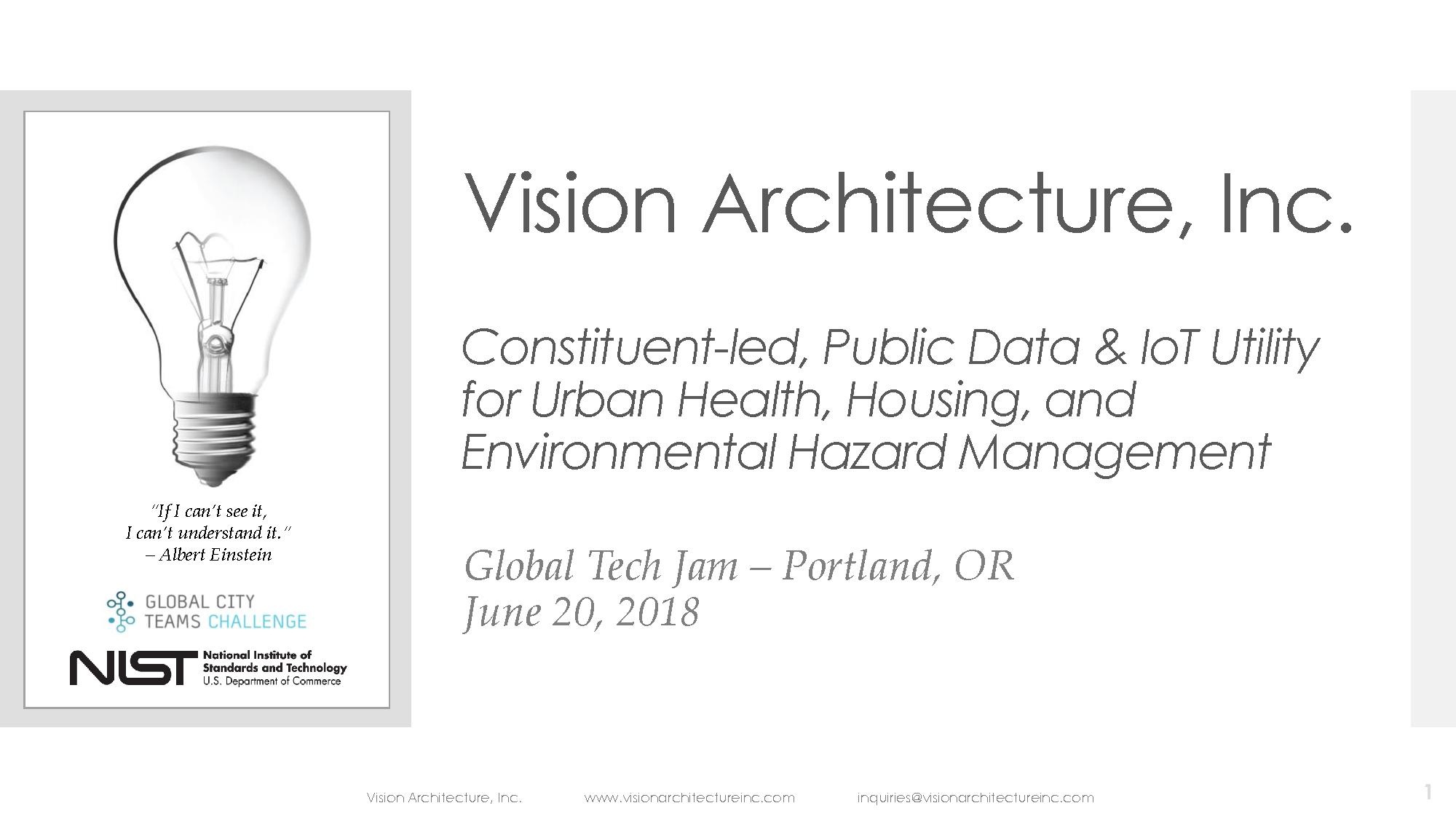
|
Description
- Build upon a Smart City blueprint, playbook, and coalition of Oakland communities to convene, share, and learn what’s possible with data, IoT, and Smart Cities then use that knowledge to co-create projects and programs germane to each constituency, micro-community, and individual sets of needs
- Leverage the coalitions to hunt and gather data for addition to a shared Public Data & IoT Utility to be operated and run as a shared data service for micro-communities to build political will, businesses to grow, and collective voice to be used to address micro- or meta-level risks and opportunities
- Leverage people, processes, and technology to collectively address issues of unsafe Bay Area Housing Environments to co-create inclusive solutions and investment opportunities to resolve the housing crisis and improve health region-wide
- Focus on short and long-term positive outcomes associated with sustainable Smart City solutions, and maintain a cadence of speed and success delivering projects to address current issues for constituents, businesses, and government agencies generated by past programs, policies, and investments like failing infrastructure, legacy lead poisoning, and institutionalized racism
Challenges
These issues have been known by communities for generations and were validated in 2015 by the Assessment Team of the Rockefeller Foundation’s 100 Resilient City Challenge. Over 100 organizations, including Vision Architecture, Inc. and SmartOakland, took part in defining solutions and a path forward shaping the future of Oakland.
Lack of Affordable and Healthy Housing, Economic, Educational, and Social Inequity
- Aging Infrastructure
- Trust in Government
- Insufficient Affordable Housing
- Education Disparities
- Limited City Resources
- Socioeconomic Disparities
- Disparities in Access to Healthcare
- High Crime Rate
- Chronic Homelessness
Environmental Hazards
- Legacy Lead Poisoning
- Sea Level Rise
- Earthquakes and Liquefaction
- Droughts
- Wildfires
- Coastal and Urban Floods
Solutions
Our solution is to kick off and enable a constituent-led agenda to create value in each community first, by sharing educational resources and expertise, then through training and preparation of people in every community to engage in data, IoT, and Smart City projects, and then by supporting pitches for funding in various communities to kick off Oakland’s leading role in the Fourth Industrial Revolution (4IR). A city-wide crowdsourcing activity will identify lead poison locations, estimate costs of resolution, and resolve issues of lead in people, housing, paint, and soil to create lead-safe neighborhoods and revitalized communities throughout the city.
Major Requirements
- Conduct Vision Architecture workshops to define vision and architecture for what constituents, businesses, and government envision for their future in Oakland. Use the output to create strategic plans coalitions will use to implement their projects throughout 147 diverse micro-communities in Oakland. Hold ongoing leadership development and community meetings to add new ideas, keep things fresh, grow fundraising abilities, and maintain community relevance.
- Pitch and secure program, staff, and project funding to sponsor resources included in the vision and strategic plans to ensure local individuals, businesses, Non-Profits, and support agencies can rollout the initiatives included in the constituent-led vision
- Create a Smart City data governance program and policy that includes members from all city stakeholders beginning with constituents and working out to include education, health, housing, sustainability, Non-Profits, public sector, technology, workforce development, and business development to create a data hierarchy, taxonomy, and permission framework for growing a new shared data service for city resources.
- Develop partnerships with Bay Area private sector companies and city leaders to ensure the Public Data & IoT Utility grows relationships with data owners and agencies to curate connections with Open Data, commercial data, IoT data, machine data, sensor data, and user contributed data to create and deploy individual-level resilience services to Oaklanders, and participating city constituents, so they are outfitted with Space Time Insight and Actionable Intelligence for every day life
- Create an inventory of all buildings in all Oakland Zip Codes to be used as reference points, which will be tied to micro-communities, community policing districts, business development districts, school districts, and we will continue to add more and more data layers including health, environment, economic, and daily concerns and opportunities.
- Build a flagship data solution around which many others will be fashioned to grow from lessons learned and hard-to-get first wins.
Performance Targets
| Key Performance Indicators (KPIs) | Measurement Methods |
|---|---|
|
We will measure our success using these Key Performance Indicators:
|
Standards, Replicability, Scalability, and Sustainability
We will create a public playbook and blueprint with live data dashboards to help cities facing issues of lead poisoning. It will include recommendations about how they can organize themselves as individuals, groups, and coalitions to start and maintain traction and progress toward lead abatement and ending lead poisoning in their cities and towns. It will be a living resource updated by Oakland stakeholders as they discover new, better, and/or alternative ways to deal with various aspects and challenges. This resource will remain available online and public data dashboards will be updated real-time as each new User chooses to share their data with the public. Standards described in the City of Oakland’s data collection and surveillance programs will also be included for reference about the types of information the city collects about constituents and how community members can get involved with setting direction and policy in the areas of cybersecurity and personal privacy.
Cybersecurity and Privacy
The plan is to run predictive data analytics to identify high probability of lead poisoned housing, as a starting point, then reach out to those occupants to explain data privacy, security, and the power of owning your health, housing, and environmental data. We will use data to begin the conversations and note we are reaching out to them because we’re relatively certain they are currently at risk for becoming lead poisoned in their pre1978 housing. We ask them to use our GTLO app to learn more about the health of their families and potential lead hazards in their homes and explain the options around sharing this data with various groups. All efforts will be made to engage community members, provide translation services, and ensure they are clear about the importance of their data, the security around it, and the value it creates for them. Once they understand the implications associated with providing access to important data with others they can use the app to start assessing their situation and make informed decisions about Cybersecurity. These diagrams represent the types of groups Users may want to share data with and the conversations we’ll be having regarding Cybersecurity and data privacy.
Impacts
Economic Benefits
- New Product Development – the Public Data & IoT Utility will become a product generator to derive new business uses and applications as it becomes a part of city and community services
- Workforce Development & New Jobs – for Data Scientists, Certified Lead Inspectors, Building Contractors, and Project Managers
- New Revenue Models for Cities – for Assessors, Inspectors, Real Estate Preservation, Smart City data integrations using Oakland data sources available as a subscription commodity
Health & Environment Benefits
- Improved Health Outcomes – reduction in need for poison-related issues that require ongoing public services including health care, special education, unemployment, housing, special needs, and law enforcement
- Improved Environment – understanding the environment inside and outside homes using data, IoT, and user contributed insight we can better monitor overall status on city health and ensure a higher quality of life and deepen equality in every community
Social Services & Equity Benefits
- New Government-to-Constituent Services
- New Regulatory & Housing Safety Policies
- New Green Housing & Energy Efficient Housing Stock
- Improvement on Social Equity Issues
Demonstration/Deployment
- Our cross-functional team will co-present to describe how constituents, community leaders, business owners, educators, parents, Non-Profits, data scientists, technologists, city and county government agencies, and youth came together to solve the issues we agreed were most critical in 2018.
This was and is the perfect storm of an unprecedented intersection of unsafe housing during a historic housing crisis in concert with the rise of the lead poisoning crisis in Oakland, CA where now the lead was not only in the paint, but also showing up in the school tap water at Oakland schools. This intersection had no precedent or leader who could address the escalating public health emergencies so this group stepped up to try.
- We will present a PowerPoint deck that demonstrates how our initial introductions allowed alliances to be formed, how agreements to total transparency were critical, along with strict adherence and compliance with HIPPA laws and data privacy, to respond to the escalating public health crisis many of us volunteered to address.
- We will then show what we thought we could learn using data and IoT to deal with the scale and complexity of the issues and what we did when things worked and when they didn’t. We’ll share lessons learned and discuss what we re-wrote in our Oakland Playbook and how many times we did it.
- Lastly, we’ll show our results. The Public Data & IoT Utility and the Space Time Insight we have created to deliver personal and group resilience services to individual constituents, businesses, and government agencies to empower people in every community to live the most informed life so they can make decisions about what will happen next.
- We’ll talk about our KPIs throughout the above topics and via slides.
